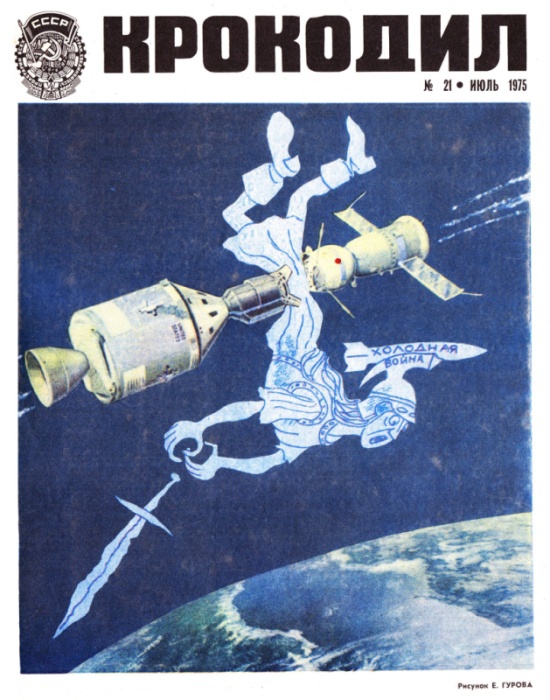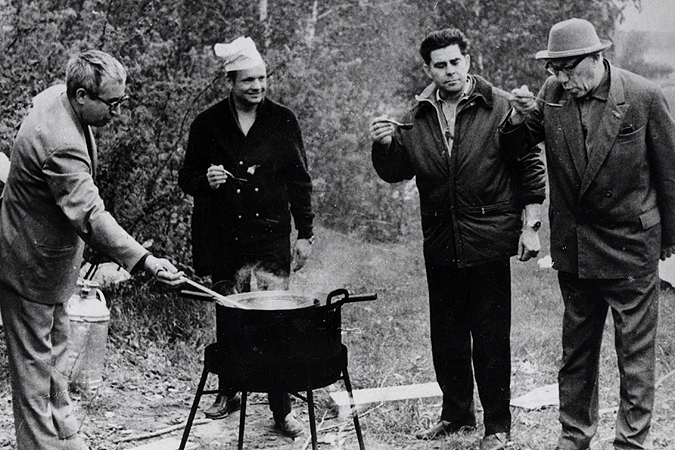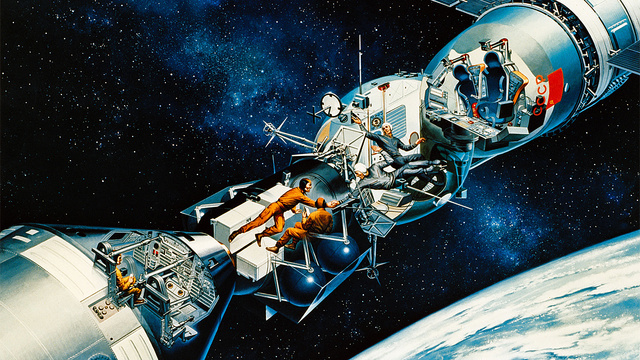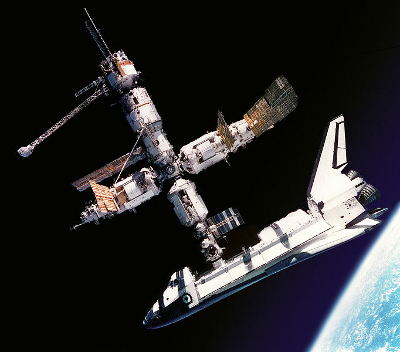The history of space cooperation

In the history of relations between the USA and the USSR / Russia, there were periods of aggravation of relations and detente, which, of course, was reflected in the level of cooperation in space exploration. Now, in the next period of aggravation of relations, I think it will be useful to recall how the interaction of our countries took place in space.
Luna 2 and the English intermediaries

From left to right: “Luna-2”, telescope them. Lavella Jodrell Bank, Eisenhower and Khrushchev
September 12, 1959. The USSR launches the Luna-2 station with the task of falling into the moon. The Soviet space program was very closed and usually did not announce preparations for the launch of any mission. In order for the world to have no doubts about the reality of this launch, it would be good to get a foreign confirmation of the signal of the lunar and a break in the signal when it enters the moon. It was not possible to contact the Americans directly - the Cold War closed the possibility of communication even for such a peaceful and scientific task. Therefore, it was decided to use an intermediary - Professor Lavell, director of the English Observatory Jodrell Bank. The calculation was that the British would report the parameters of the station’s flight to the Americans, who would track the flight of Luna-2 with their observatories. And so it happened, already on September 14, when the station crashed into the moon,
September 15, 1959 Khrushchev made a historic visit to the United States as part of a warming relationship between the superpowers, and a copy of the pennant that was delivered by Luna-2 to the Moon was donated to Eisenhower.
Curiously, for the lunar assault rifles of the E-1 series, the Cold War did not end on this episode. The USSR organized an exposition of its achievements, which traveled to exhibitions in capitalist countries. And the CIA ran a whole spy operationwith the involvement of dozens of people, in order to secretly gain access to the exhibition copy, take measurements and photographs, as well as steal several wires that were forgotten in the station. It was found that this is a serial device, and not a model prepared for the exhibition, made fifth in a row. Also, according to the measurement results, it was possible to make assumptions about the engine and the characteristics of the third stage ( block "E" ).
High visits

Tereshkova fastens the badge to Armstrong in the CPC.
And astronauts and astronauts visited the cities of the "probable enemy." In 1962, Titov visited the United States:

Glenn, Kennedy, Titov
( you can see the film ).
In 1969, astronaut Frank Borman (Gemini 7, Apollon 8) visited the USSR ( News of the day ), in 1970 Neil Armstrong:

Ear in the wild in the Novosibirsk region. From left to right: Feoktistov, Armstrong, Beregovoi, academician Lavrentiev, source of the photo .
What is characteristic, people were happy to meet that of astronauts, that of astronauts.
Spy Story with Lunokhod-2

After the landing of Lunokhod-2, an almost espionage story occurred. I will quote "Cosmonautics News", No. 23, 1995 :
Oleg Genrikhovich Ivanovsky told about an extremely interesting story about the photocard of the area of work of Lunokhod-2. Immediately after the landing of Moon-21 in the Sea of Clarity, an American delegation arrived in Moscow to discuss the results and tasks of studying the planets of the solar system. The meeting was held from January 29 to February 2, 1973 at the IKI of the USSR Academy of Sciences. By that time, the coordinates of the Lunokhod-2 landing had already been announced. At a meeting at IKI, one of the American scientists carefully approached Ivanovsky and put a photograph in his jacket pocket. It turned out to be a detailed photograph of the landing area of the Moon-21. The area was shot by the Americans in anticipation of the landing of the lunar module of Apollo 17. Using this photo in the future, the Lunokhod-2 route was planned.
The “thrown” photographs turned out to be better than what Soviet scientists had, and the new knowledge even changed the program of the Lunokhod-2 movement
Soyuz Apollo

1970 year. The Vietnam War continues. The USSR supports North Vietnam with weapons and military advisers, the United States fully fights on the side of South Vietnam and invades Cambodia in May. Nevertheless, on the initiative of Academician Keldysh and NASA Director Thomas Payne, an experimental joint flight program begins. In October 1970 , a meeting of two delegations takes place, working groups are created for the compatibility of Soviet and American ships. The program was officially approved on May 24, 1972.
Probably one of the main problems was the difference in the atmospheres of the ships. In Soyuz, the atmosphere was with terrestrial parameters (~ 1 atm, oxygen and nitrogen). In Apollo, pure oxygen at a pressure of 0.35 atm. If the ships simply connected and opened the hatches, then the atmospheric automation of the life support system could not work on both ships, and the cosmonauts on the Soyuz would feel the symptoms of decompression sickness due to a drop in pressure. Therefore, firstly, the atmosphere of both ships was slightly changed (the pressure was reduced on the Soyuz and increased on the Apollo), and secondly, a transitional lock was developed, in which after an hour of lock-up it would be possible to go from the ship to ship.
The second interesting technical detail was the androgynous docking unit, which could be used for both passive (the one that was waiting for the dock) and active (the one that maneuvered for the dock) ships. Other versions of this unit were used in subsequent joint programs.
Meanwhile, the Vietnam War was on the decline - the US was withdrawing from participation in it. April 30, 1975 the troops of North Vietnam took Saigon, having won a complete and unconditional victory. Vietnam became communist. And on May 15, Soyuz and Apollo started for docking and joint flight.
The mission was very successful from a technical and political point of view. Soyuz Apollo is probably the best point to mark the end of the Space Race.
Shuttle World

In the 1980s, anything happened between the USSR and the USA. Reagan talked about the "evil empire" and "declared a nuclear war" before speaking on the radio. The United States supported the Mujahideen in Afghanistan. The USSR fought with the Mujahideen and conducted large-scale military exercises, testing its readiness for a global nuclear war. But there was also the Shuttle-Salyut program, in which it was proposed to organize Space Shuttle flights to the long-term Salyut orbital stations. Unfortunately, this proposal did not go beyond ideas.
After the USSR lost the Cold War, the idea was developed as the Shuttle-Mir project. The United States did not have its own orbital stations, and the construction of the Freedom station in the 80s was canceled due to lack of money. And in Russia there was a Mir station and a serious problem with money for astronautics in the chaos of the 90s. Therefore, already in 1993, a program of joint flights to the Mir station at the Soyuz and Shuttle was announced. Thanks to this cooperation, the Spectrum and Nature modules appeared on Mir, on which the equipment of both the Russian Federation and the USA stood, as well as a docking module for providing shuttle dockings (with a docking assembly - the development of the Soyuz-Apollo assembly). The Spectrum module was launched after a five-year hiatus in the construction of the Mir station, and without the Shuttle-Mir program it would most likely not have been.
The Shuttle World program yielded very good results. During seven expeditions, 34 astronauts visited the Mir, the Americans flew in the crew of the Soyuz for the first time, and the Russians shuttle, many scientific experiments were carried out, interaction was established for the construction of the ISS.
ISS
If you think about it, and at least temporarily shake off the habit of perception, then the ISS is a real wonder of the world. A huge station weighing 417 tons with a permanent crew of six people, built with the participation of 15 countries and recently celebrated its fifteenth anniversary. A real outpost of mankind in space, born of collaboration on a planetary scale and giving hope for the advancement of man beyond the limits of the earth's orbit. Moreover, in addition to the direct scientific goal, the ISS is also changing us. Astronaut Mike Mullane in his book Riding Rockets: The Outrageous Tales of a Space Shuttle Astronaut wrote (my translation):
The ISS was built in collaboration with the Russians. Godless commies have become our friends. Even Bill Shepherd , who wrote “Swallow It, Commies” in the STS-27 mission’s secret payload, turned into Comrade Shepherd, who spent five months on the ISS with two Russians.
Commentary on recent events
Alas, it is impossible not to comment on recent news about the termination of NASA’s cooperation with Russia. I am sad that the US government put NASA in such a stupid and uncomfortable position:
- First of all, the concept “here we are cooperating, here we are not cooperating, here the fish was wrapped up” is perplexing. If you want to quarrel so much, why not announce something more rational in the style of “We will execute the programs already begun, but we will not start new ones”?
- A consequent break in cooperation will cause damage to both parties, but, to a greater extent, to NASA. It's no secret that NASA will not be able to launch astronauts to the ISS on its own until at least 2017, and has already signed a launch contract until the summer of 2017. The American segment of the ISS is not self-sufficient and cannot go into free swimming. It is also no secret that even the US military payload is now launched on Atlas missiles with Russian RD-180 engines (the fiftieth launch just recently took place). Are you planning to break off relations here? What, then, will the United Launch Alliance do, which makes money on these launches? What to do Orbital Sciences Corporation, one of the now-praised "private companies" with the Antares rocket, which uses the NK-33?
- Fresh news about what appears to be "the State Department did not require NASA to suspend cooperation with Russia" is doubly perplexing .
With such news, it remains only to express the hope that our overseas partners will calm down and act more rationally.
And, in conclusion, the very good position of cosmonaut Alexander Lazutkin:
